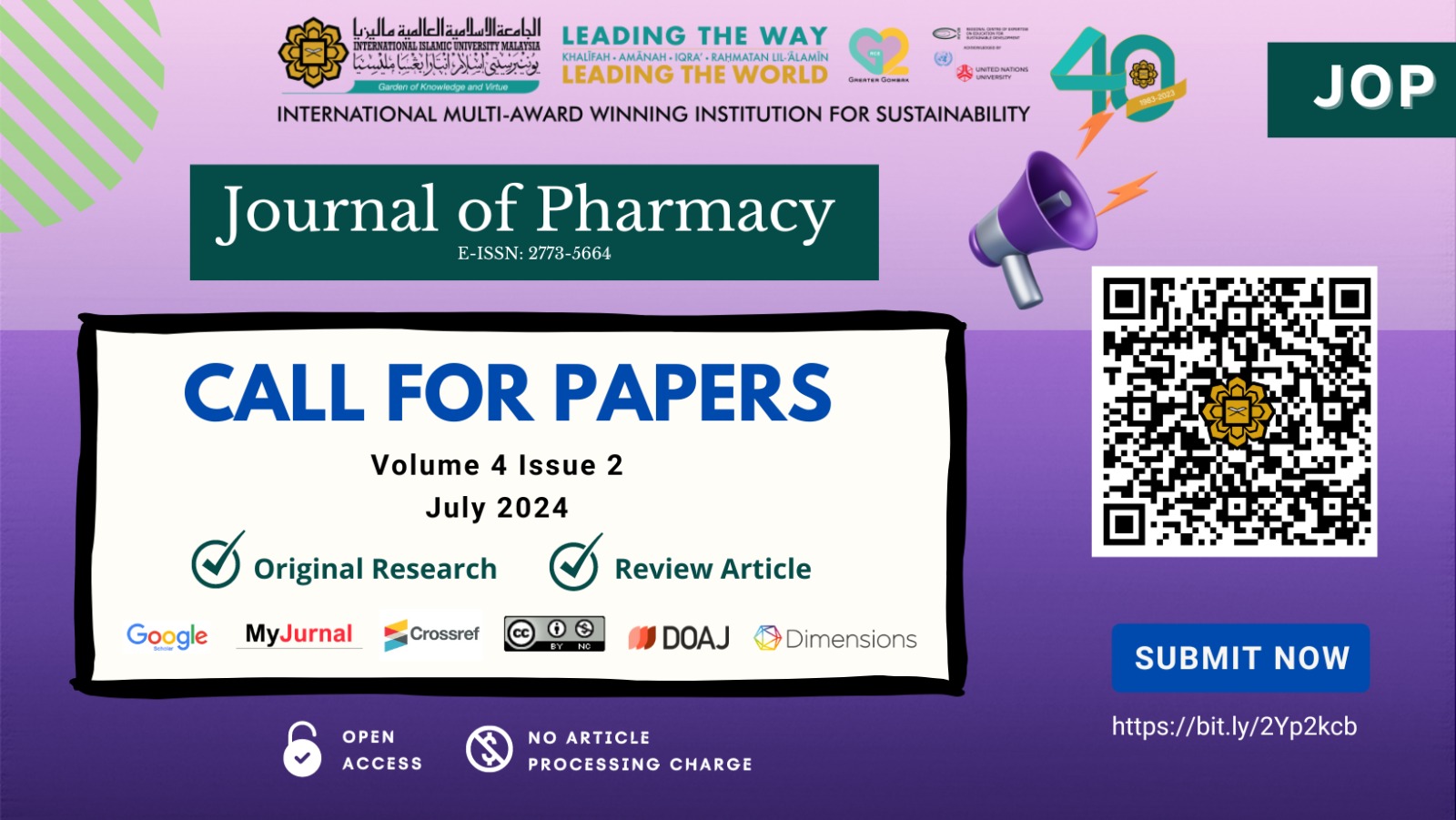Factors affecting waiting time in Outpatient Pharmacy at Hospital Raja Perempuan Zainab II (HRPZ II)
DOI:
https://doi.org/10.31436/jop.v2i1.105Keywords:
Waiting time, association, outpatient pharmacyAbstract
Introduction: World Health Organization (WHO) has identified that patient waiting time as one of the most important measurements of a responsive health system for healthcare services. Outpatient pharmacy is associated with patient waiting time as the indicator for satisfaction of the services. This study aimed to determine the factors affecting waiting time in Hospital Raja Perempuan Zainab II, Kelantan. Materials and method: A cross sectional study was conducted by collecting prescription received in outpatient pharmacy from 1st October 2020 till 31st December 2020. All prescriptions prescribed manually were excluded. Multiple linear regression was performed to determine the factors affecting waiting time and the data were analysed using SPSS version 25. Results: A total of 248 prescriptions were collected in outpatient pharmacy. The mean waiting time in outpatient pharmacy was 23.0 minutes (SD = 11.0). Waiting time was found to be associated with number of medications in the prescription, number of staff working on that day, prescriptions which required intervention and filling personnel. Conclusion: The waiting time at the outpatient pharmacy of HRPZ II indicated the acceptable range of quality services which met the patient’s satisfaction. Future studies are needed to confirm the satisfaction level of patients and further improve quality of the service.
References
Afolabi, M. O., & Erhun, W. O. (2003). Patients' response to waiting time in an out-patient pharmacy in Nigeria. Tropical Journal of Pharmaceutical Research, 2(2), 207-214.
Ahmad, B. A., Khairatul, K., & Farnaza, A. (2017). An assessment of patient waiting and consultation time in a primary healthcare clinic. Malaysian Family Physician, 12(1), 14-21.
Alderman, C. P., & Farmer, C. (2001). A brief analysis of clinical pharmacy interventions undertaken in an Australian teaching hospital. Journal of Quality in Clinical Practice, 21(4), 99-103.
Alodan, A., Alalshaikh, G., Alqasabi, H., Alomran, S., Abdelhadi, A., & Alkhayyal, B. (2020). Studying the Efficiency of Waiting Time in Outpatient Pharmacy. MethodsX, 7, 100913.
Arafeh, M., Barghash, M. A., Sallam, E., & AlSamhouri, A. (2014). Six Sigma applied to reduce patients' waiting time in a cancer pharmacy. International Journal of Six Sigma and Competitive Advantage, 8(2), 105-124.
Fauzia, U., Setiawati, E. P., & Surahman, E. S. (2017). Analysis of Waiting Time for Filing Prescriptions in Hospital Pharmacy. Pharmacology and Clinical Pharmacy Research, 2(3), 78-80.
Ghaibi, S., Ipema, H., & Gabay, M. (2015). ASHP guidelines on the pharmacist’s role in providing drug information. American Journal of Health-System Pharmacy, 72(7), 573-577.
Green, S. B. (1991). How many subjects does it take to do a regression analysis. Multivariate Behavioral Research, 26(3), 499-510.
Hammouda, E., & Hammouda, S. (2012). Outpatient (Ambulatory) pharmacy; an innovation in dispensing system to optimize performance and meet standards. Pharmaceutic Regulatory Affair, 1(1), 1000101.
Huang, X.-M. (1994). Patient attitude towards waiting in an outpatient clinic and its applications. Health Services Management Research, 7(1), 2-8.
IBM Corp. (2017). IBM SPSS Statistics for Windows, Version 25.0. Armonk, NY: IBM Corp.
Kim, Y., & Schepers, G. (2003). Pharmacist intervention documentation in US health care systems. Hospital Pharmacy, 38(12), 1141-1147.
Kusumowardhani, D., & Ilyas, Y. (2019). Waiting Time of Pharmacy Service as an Indicator of Patient Satisfaction: A Systematic Review. Paper presented at the 6th International Conference on Public Health 2019.
Lin, A. C., Jang, R., Lobas, N., Heaton, P., Ivey, M., & Nam, B. (1999). Identification of factors leading to excessive waiting times in an ambulatory pharmacy. Hospital Pharmacy, 34(6), 707-713.
Loh, B. C., Wah, K. F., Teo, C. A., Khairuddin, N. M., Fairuz, F. B., & Liew, J. E. (2017). Impact of value added services on patient waiting time at the ambulatory pharmacy Queen Elizabeth Hospital. Pharmacy Practice (Granada), 15(1), 846.
Ndukwe, H. C., Tayo, F., & Sariem, N. (2011). Factors influencing waiting time in outpatient pharmacy of Lagos University Teaching Hospital. International Research Journal of Pharmacy, 2(10), 22-26.
Nosek Jr, R. A., & Wilson, J. P. (2001). Queuing theory and customer satisfaction: a Review of terminology, trends, and applications to pharmacy practice. Hospital Pharmacy, 36(3), 275-279.
Sadi, B. M. A., Harb, Z., El-Dahiyat, F., & Anwar, M. (2019). Improving patient waiting time: A quality initiative at a pharmacy of a public hospital in United Arab Emirates. International Journal of Healthcare Management, 14(3), 1-6.
Sun, J., Lin, Q., Zhao, P., Zhang, Q., Xu, K., Chen, H., . . . Liu, Y. (2017). Reducing waiting time and raising outpatient satisfaction in a Chinese public tertiary general hospital-an interrupted time series study. BMC Public Health, 17(1), 1-11.
Suss, S., Bhuiyan, N., Demirli, K., & Batist, G. (2017). Toward implementing patient flow in a cancer treatment center to reduce patient waiting time and improve efficiency. Journal of Oncology Practice, 13(6), e530-e537.
Tan, W. S., Chua, S. L., Yong, K. W., & Wu, T. S. (2009). Impact of pharmacy automation on patient waiting time: an application of computer simulation. Annals Academy of Medicine Singapore, 38(6), 501.
Yang, J.-h., Liao, Y.-f., Lin, W.-b., & Wu, W. (2019). Prescribing errors in electronic prescriptions for outpatients intercepted by pharmacists and the impact of prescribing workload on error rate in a Chinese tertiary-care women and children’s hospital. BMC Health Services Research, 19(1), 1013.
Yi, F., Ahmad, A., Said, N., Manshor, T., Ling, S. O. O., Jamil, N., & Roby, B. (2021). Identification of factors leading to excessive waiting time at the pharmacy unit of health clinics in Temerloh district, Pahang, Malaysia. Malaysian Journal of Pharmaceutical Sciences, 19, 97-111.
Downloads
Published
How to Cite
Issue
Section
License
Copyright (c) 2022 IIUM Press

This work is licensed under a Creative Commons Attribution 4.0 International License.
Journal of Pharmacy at https://journals.iium.edu.my/ktn/index.php/jp is licensed under a Creative Commons Attribution 4.0 International License.












